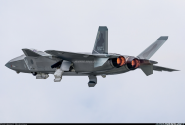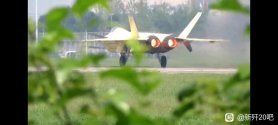Radar reflections also isn't as simple as reflecting a light off a mirror. Some electromagnetic waves will travel along the surface of the object and scatter only when it reaches an abrupt discontinuity. In practice, this means that just because two things are in the same plane doesn't mean the object in the front will shield the object in the back.One frequent criticisms of J-20's stealth is the canards, however, nobody has ever criticized F-22's protruding twin rear horizontal stabilizers as degrading RCS or VLO performance. As far as physical protrusion, twin horizontal rear stabilizers are essentially permanently locked canards in the rear of the aircraft, yet F-22 stealth isn't compromised. Neither are canards for J-20 stealth!
"Hurr durr, they stick out of the plane like popsicles sticks"
Now I concede that F-22's twin rear horizontal stabilizers are flush & parallel with the aircraft body, but so are J-20's canards during BVR combat at long-distance and supercruising? If I understand correctly, the canards are activated (non-parallel to body) during high AoA which is essentially WVR where VLO isn't even important anymore.... but they are "locked" in parallel position during BVR long-range where RCS and VLO performance is utmost importance? Just wanted to confirm if the logic is correct because the canard criticism is so damn frustrating.
You are using an out of date browser. It may not display this or other websites correctly.
You should upgrade or use an alternative browser.
You should upgrade or use an alternative browser.
J-20 5th Gen Fighter Thread VIII
- Thread starter Blitzo
- Start date
Not the butt pics I wanted.
Not the butt pics I wanted.
Maybe in five years we'll get a clear picture of J-20A with WS-15 nozzles.
Enjoy the wait meanwhile.
you mean ws15 will be onboard j20A en-massed in 5 years?Maybe in five years we'll get a clear picture of J-20A with WS-15 nozzles.
Enjoy the wait meanwhile.
The nozzle petals seem like one piece and not articulated as on the J-10B TVC
The nozzle petals seem like one piece and not articulated as on the J-10B TVC
Correct. WS-15 does not have TVC yet.
First of all I am not arguing for WS-15 on that J-20 has TVC, far from it. But I don't think that picture is clear and sharp enough to draw any conclusions.The nozzle petals seem like one piece and not articulated as on the J-10B TVC





